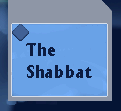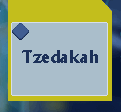
The Jewish Calendar
To understand most of the biblical events, be them from Tanakh or from Brit Chadashah, we have to understand how time was reckoned in the biblical era. This knowledge will not only infuse life into the understanding of the Bible in general, but also meaning into our observances of the holidays, thus allowing us to have a deeper expression in our worship of God.
Genesis 1:14: “And God said, Let there be lights in the firmament of the heaven to divide the day from the night; and let them be for signs, and for seasons, and for days, and years.”
God tells us with the creation account to use the lights of heaven, the sun, the moon and the stars to divide seasons, days and years, in other words, to count time using the celestial bodies. Therefore, this is what the people in the biblical time did; they used the stars, the sun and the moon to devise their calendar. We cannot speculate how much scientific knowledge they had, nor how much was given to them by God, but we surely can agree that they were much closer to nature than us by being more dependent on it, thus, their observations of natural changes were much keener. There were no street lights to compete with the brightness of the night sky, no city noise to compete with the rustling of the wind, and there were no man made devices to interfere with the nature’s life cycle. Everything that happened around them had an impact in their lives; therefore, they had to learn fast. They were forced to observe the changes in the temperature - the seasons – because these changes dictated their agricultural necessities, thus, their very existence. Their food supply from either cattle or grain was depended on the understanding of the changing of the seasons.
We read references in the Bible as to the early rain (Hebrew: yoreh) and the latter rain (Hebrew: malkosh), referring to the rain right before the planting in fall and, respectively, to the rain that came before the harvesting in spring. Even though these were natural occurrences – forces put in motion by God when He created the universe – as Bible believers, we cannot dismiss the correlation between people’s obedience to God’s commandments and the blessings that will come through these natural forces. Deuteronomy 11: 13-14: “And it shall come to pass, if you shall give heed diligently to My commandments which I command you this day, to love the Lord your God, and to serve Him with all your heart and with all your soul, then I will give you the rain (matar) for your land in its season, the early rain (yoreh) and the latter rain (malkosh), that you may gather in your grain, your new wine, and your oil.” And in the same time we have to make a distinction between the natural occurrences of these forces and God’s interventions as told in Deuteronomy 28: 1,24: “But it shall come to pass, if you will not listen to the voice of the Lord your God, to take care to do all His commandments and His statutes which I command you this day; that all these curses shall come upon you, and overtake you… the Lord shall make the rain (matar) of your land powder and dust.” Even though the rain will come down dictated by the natural physical forces, God could intervene and make those rains a destructive force instead, powder and dust. In our day-and-age it is harder to make this distinction because we moved so far from a close relationship with God and with nature. Never-the-less, God made it clear that there will be consequences, blessing and curses; our relationship with God will have a direct impact on nature.
As a student of the Bible I have to pause for a brief paragraph to notice a correlation that the Brit Chadashah makes to the seasons: James 5:7: “Have patience, therefore, brethren, until the coming of the Lord. Take notice how the farmer awaits the precious fruit of the earth, having patience for it until it receives the early rain and the late rain. You must also have patience; strengthen your hearts, because the coming of the Lord has drawn near.” So too the apostle is using the seasons as an example in “harvesting” Lord’s people as in the early rain and in the latter rain. The early rain (yoreh) is a gentle but steady rain to moisten and penetrate the soil preparing it for sowing. The latter rain (malkosh) is the rain that strengthens the crops making them ready for harvest. By having a close relationship with the Lord we can better understand His words and meaning and, thus, we can better understand His plan of salvation for mankind and be better workers in His field. When we approach a pre-believer, we want to be gentle and steady. Building a relationship is more important than giving them knowledge. Later, when their heart and mind are ready, we can show (pour on) them the hard facts of the Bible. The correlation that the apostle makes in this passage is that understanding the times and the seasons given to us by God through observing nature brings us closer to Him.
Therefore let’s press on. By observing the changes in the seasons, what we count today as one earth revolution around the sun, they counted it as one growth cycle, thus, one year. The observance of the moon provided a finer division of seasons with its repetitions as it revolves around the earth which can be easily seen and discerned. Therefore, the appearance of the moon from a tiny sliver to a full body and back to a tiny sliver - one moon revolution around the earth – was counted as one month. The appearance of the first sliver was called New Moon and the full body, Full Moon.
But there was one division of time that people observed first, as their bodies needed rest and sleep, the day. Therefore, the appearance of day and night - one earth rotation around its axis - will count for one day. Also, the observation of this rotation of earth compared with the position of the sun provided a further division of the day. This rotation was, and is perceived and talked about even today, even though we have all this modern scientific knowledge, as the rising and setting of the sun. Thus, by observing the position of the sun in relation to the horizon, the day was further divided, first in quadrants and later in hours.
The first instrument that people devised to tell time, I believe, was the sundial. As far back as the archeology can investigate, the sundial dates to the Egyptian period, from around 1500 BCE It started with telling noon then it had six divisions and then around 300 BCE 12 divisions, or as we call them today, hours. The Bible mentions some kind of sundial in Isaiah 38:8: “Behold, I will turn the shadow of the degrees, which has gone down in the sun dial of Ahaz, ten degrees backward. So the sun turned back ten degrees, by which degrees it had gone down in the dial.” Again, this is written from an observer point of view, not based on their scientific knowledge. We pretend to be much more sophisticated and knowledgeable today, but we use same phrases, the sun is setting, or the sun is rising, based on observation and not science. (Keep in mind that the mechanical clock was invented much later around the 13th century CE.)
During this Biblical period these observations of the celestial bodies were done by the priests. That was because the priests were entrusted with executing God’s commandments; therefore, they needed to discern the appointed times for sacrifices, feasts and celebrations. The commandment "Keep the month of Aviv" (Deuteronomy 16:1) involved a keen observation of the position of the sun in relation to the moon in determining the equinoxes of the year. This process was known as the “Fixing of the Month.” Later it took the more popular Hebrew name “Kadosh haHodesh” – “Sanctification of the New Moon.”
At the beginning of the Talmudic time the Sanhedrin - the leading religious body comprising of 71 members - established rules and regulations for fixing the New Moon by the examination of witnesses. Two witnesses will come forward and declare to the Sanhedrin that they observed the appearance of the New Moon, thus was announced throughout the country that a new month began. In the course of time scientific calculations were worked out by the rabbis. Samuel of Nahardea (165-250 CE) compiled a calendar for a sixty-year period, and Hillel II (330-365 CE) established rules for the computation of the calendar that permanently fixed the observance of all holidays for the Jewish people everywhere, as we have it today.
Therefore, these are the Divisions of Time in the traditional Jewish calendar:
|


 Is Messianic Judaism Biblical Judaism?
Is Messianic Judaism Biblical Judaism?  What is the Jewish Calendar?
What is the Jewish Calendar? The Jewish Holy Days are the seven God's Holy Days.
The Jewish Holy Days are the seven God's Holy Days. The Shabbat is the seventh day which God sanctified and set apart for worship.
The Shabbat is the seventh day which God sanctified and set apart for worship. Tzedakah, the righteous giving.
Tzedakah, the righteous giving.